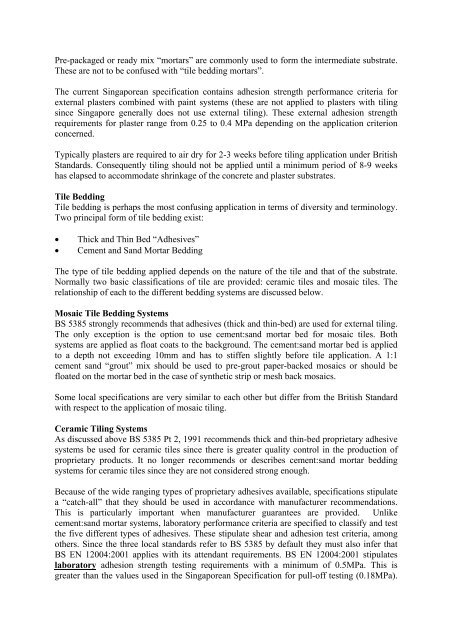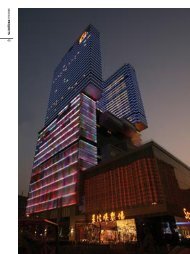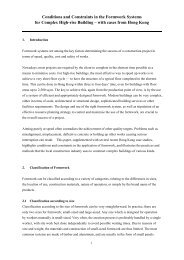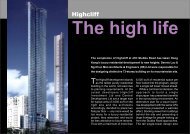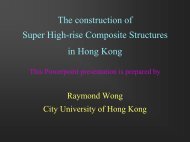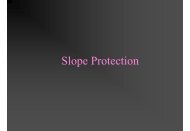installation and maintenance of external façade tiles on tall buildings
installation and maintenance of external façade tiles on tall buildings
installation and maintenance of external façade tiles on tall buildings
Create successful ePaper yourself
Turn your PDF publications into a flip-book with our unique Google optimized e-Paper software.
Pre-packaged or ready mix “mortars” are comm<strong>on</strong>ly used to form the intermediate substrate.These are not to be c<strong>on</strong>fused with “tile bedding mortars”.The current Singaporean specificati<strong>on</strong> c<strong>on</strong>tains adhesi<strong>on</strong> strength performance criteria for<str<strong>on</strong>g>external</str<strong>on</strong>g> plasters combined with paint systems (these are not applied to plasters with tilingsince Singapore generally does not use <str<strong>on</strong>g>external</str<strong>on</strong>g> tiling). These <str<strong>on</strong>g>external</str<strong>on</strong>g> adhesi<strong>on</strong> strengthrequirements for plaster range from 0.25 to 0.4 MPa depending <strong>on</strong> the applicati<strong>on</strong> criteri<strong>on</strong>c<strong>on</strong>cerned.Typically plasters are required to air dry for 2-3 weeks before tiling applicati<strong>on</strong> under BritishSt<str<strong>on</strong>g>and</str<strong>on</strong>g>ards. C<strong>on</strong>sequently tiling should not be applied until a minimum period <str<strong>on</strong>g>of</str<strong>on</strong>g> 8-9 weekshas elapsed to accommodate shrinkage <str<strong>on</strong>g>of</str<strong>on</strong>g> the c<strong>on</strong>crete <str<strong>on</strong>g>and</str<strong>on</strong>g> plaster substrates.Tile BeddingTile bedding is perhaps the most c<strong>on</strong>fusing applicati<strong>on</strong> in terms <str<strong>on</strong>g>of</str<strong>on</strong>g> diversity <str<strong>on</strong>g>and</str<strong>on</strong>g> terminology.Two principal form <str<strong>on</strong>g>of</str<strong>on</strong>g> tile bedding exist:• Thick <str<strong>on</strong>g>and</str<strong>on</strong>g> Thin Bed “Adhesives”• Cement <str<strong>on</strong>g>and</str<strong>on</strong>g> S<str<strong>on</strong>g>and</str<strong>on</strong>g> Mortar BeddingThe type <str<strong>on</strong>g>of</str<strong>on</strong>g> tile bedding applied depends <strong>on</strong> the nature <str<strong>on</strong>g>of</str<strong>on</strong>g> the tile <str<strong>on</strong>g>and</str<strong>on</strong>g> that <str<strong>on</strong>g>of</str<strong>on</strong>g> the substrate.Normally two basic classificati<strong>on</strong>s <str<strong>on</strong>g>of</str<strong>on</strong>g> tile are provided: ceramic <str<strong>on</strong>g>tiles</str<strong>on</strong>g> <str<strong>on</strong>g>and</str<strong>on</strong>g> mosaic <str<strong>on</strong>g>tiles</str<strong>on</strong>g>. Therelati<strong>on</strong>ship <str<strong>on</strong>g>of</str<strong>on</strong>g> each to the different bedding systems are discussed below.Mosaic Tile Bedding SystemsBS 5385 str<strong>on</strong>gly recommends that adhesives (thick <str<strong>on</strong>g>and</str<strong>on</strong>g> thin-bed) are used for <str<strong>on</strong>g>external</str<strong>on</strong>g> tiling.The <strong>on</strong>ly excepti<strong>on</strong> is the opti<strong>on</strong> to use cement:s<str<strong>on</strong>g>and</str<strong>on</strong>g> mortar bed for mosaic <str<strong>on</strong>g>tiles</str<strong>on</strong>g>. Bothsystems are applied as float coats to the background. The cement:s<str<strong>on</strong>g>and</str<strong>on</strong>g> mortar bed is appliedto a depth not exceeding 10mm <str<strong>on</strong>g>and</str<strong>on</strong>g> has to stiffen slightly before tile applicati<strong>on</strong>. A 1:1cement s<str<strong>on</strong>g>and</str<strong>on</strong>g> “grout” mix should be used to pre-grout paper-backed mosaics or should befloated <strong>on</strong> the mortar bed in the case <str<strong>on</strong>g>of</str<strong>on</strong>g> synthetic strip or mesh back mosaics.Some local specificati<strong>on</strong>s are very similar to each other but differ from the British St<str<strong>on</strong>g>and</str<strong>on</strong>g>ardwith respect to the applicati<strong>on</strong> <str<strong>on</strong>g>of</str<strong>on</strong>g> mosaic tiling.Ceramic Tiling SystemsAs discussed above BS 5385 Pt 2, 1991 recommends thick <str<strong>on</strong>g>and</str<strong>on</strong>g> thin-bed proprietary adhesivesystems be used for ceramic <str<strong>on</strong>g>tiles</str<strong>on</strong>g> since there is greater quality c<strong>on</strong>trol in the producti<strong>on</strong> <str<strong>on</strong>g>of</str<strong>on</strong>g>proprietary products. It no l<strong>on</strong>ger recommends or describes cement:s<str<strong>on</strong>g>and</str<strong>on</strong>g> mortar beddingsystems for ceramic <str<strong>on</strong>g>tiles</str<strong>on</strong>g> since they are not c<strong>on</strong>sidered str<strong>on</strong>g enough.Because <str<strong>on</strong>g>of</str<strong>on</strong>g> the wide ranging types <str<strong>on</strong>g>of</str<strong>on</strong>g> proprietary adhesives available, specificati<strong>on</strong>s stipulatea “catch-all” that they should be used in accordance with manufacturer recommendati<strong>on</strong>s.This is particularly important when manufacturer guarantees are provided. Unlikecement:s<str<strong>on</strong>g>and</str<strong>on</strong>g> mortar systems, laboratory performance criteria are specified to classify <str<strong>on</strong>g>and</str<strong>on</strong>g> testthe five different types <str<strong>on</strong>g>of</str<strong>on</strong>g> adhesives. These stipulate shear <str<strong>on</strong>g>and</str<strong>on</strong>g> adhesi<strong>on</strong> test criteria, am<strong>on</strong>gothers. Since the three local st<str<strong>on</strong>g>and</str<strong>on</strong>g>ards refer to BS 5385 by default they must also infer thatBS EN 12004:2001 applies with its attendant requirements. BS EN 12004:2001 stipulateslaboratory adhesi<strong>on</strong> strength testing requirements with a minimum <str<strong>on</strong>g>of</str<strong>on</strong>g> 0.5MPa. This isgreater than the values used in the Singaporean Specificati<strong>on</strong> for pull-<str<strong>on</strong>g>of</str<strong>on</strong>g>f testing (0.18MPa).


